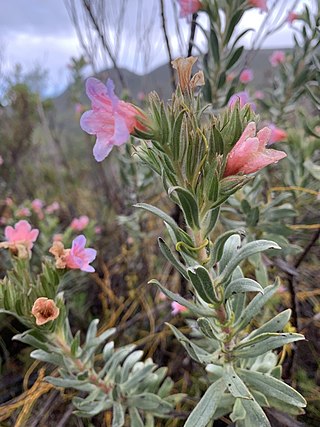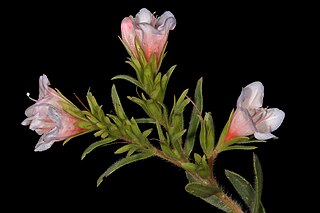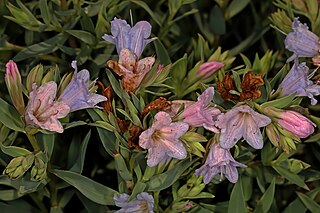
Leucospermum calligerum is a softly hairy shrub, with wand-like branches, entire ovate leaves that have a bony tip of about 25 × 6 mm, and globular heads of 2–3½ cm (0.8–1.4 in) in diameter, with two to six together near the tip of the branches and flowering in turn, that consist of 4-merous flowers, initially cream-colored, later pink, with the petals curled and the styles 2–2½ cm (0.8–1.0 in) long, sticking out like pins from a cushion. It is called arid pincushion or common louse pincushion in English and rooiluisie in Afrikaans. Well-scented flowers can be found from July to January. It naturally occurs in fynbos in the Northern Cape and Western Cape provinces of South Africa.

Felicia dregei is an evergreen, glandular shrub of up to 11⁄2 m (5 ft) high, that is assigned to the family Asteraceae. It has flat, finely felty, grayish green, narrowly elliptic to lance-shaped leaves of up to 4 cm long and 8 mm wide, with an entire margin or here and there with up to ten teeth. The flower heads have about ten violet ray florets, encircling many yellow disc florets. This species grows in the Northern Cape and Western Cape provinces of South Africa.

Felicia namaquana is a glandular-hairy, branching annual plant of up to 25 cm (10 in) high that is assigned to the family Asteraceae. It is sometimes called Bloublommetjie or pers poublom in Afrikaans. Flowering occurs between May and October. It grows in Namibia and South Africa.

Lobostemon is a genus of flowering plants belonging to the family Boraginaceae. It is endemic to the Cape Provinces of South Africa. The majority of species are limited to the winter rainfall area of the country, from Springbok to Mossel Bay. In Afrikaans these species are known as agtdaegeneesbos, or loosely translated, bush that will heal in eight days. As this name suggests, many species have medicinal properties. This is best known from Lobostemon fruticosus, which is used for treating wounds, blood poisoning, ringworm, skin diseases and syphilis.

Otholobium saxosum is a small shrublet of up to 20 cm (7.9 in) high that has been assigned to the Pea family, with branches upright or horizontal at the base with rising tips. It has sessile, clover-like leaves and white, pea-like flowers that grow in triplets in the axils of the upper leaves of new, short side shoots. The species is only known from Garcia's Pass in Western Cape province of South Africa. Flowering occurs in October and November.

Lobostemon montanus, the turquoise bush bugloss, mountain lobostemon or agtdaegeneesbos, is a South African species belonging to the forget-me-not family.

Lobostemon argenteus, or the silver healthbush, blue rocket bugloss or disselblaarluibos, is a species in the forget-me-not family that is endemic to South Africa.

Lobostemon belliformis, the Gouriqua lobostemon or beaut healthbush, is a critically endangered species in the forget-me-not family. It is known from a single locality on the Riversdale Plain in South Africa.

Lobostemon capitatus is a species belonging to the forget-me-not family. It is endemic to the Western Cape of South Africa, where it is found between Porterville and Bredasdorp.

Lobostemon curvifolius, the largeflower healthbush, is a species of the forget-me-not family from South Africa.
Lobostemon collinus, the pyjamabush or iron healthbush, is a species belonging to the forget me not family. It is known only from the fynbos biome of the Western Cape of South Africa.
Lobostemon cinereus, the ash healthbush, is a species belonging to the forget-me-not family. It is endemic to the Cape Provinces of South Africa.
Lobostemon daltonii, the Infanta healthbush, is a species of the forget-me-not family endemic to the Cape Provinces of South Africa.
Lobostemon decorus, the Rooiberg healthbush, is a species belonging to the forget-me-not family. It is endemic to the Western Cape of South Africa.

Lobostemon fruticosus, also known as the eightday healthbush or pyjamabush, is a species of medicinal plant endemic to the Cape Provinces of South Africa. It is considered to be ecologically and economically important but is declining due to overexploitation.
Lobostemon glaber, the renoster healthbush, is a species of plant from South Africa. It is in the forget-me not family.

Lobostemon glaucophyllus, the smooth-leaved bush bugloss or grey healthbush, is a South African plant species belonging to the forget-me-not family. It is endemic to South Africa's Cape Provinces.
Nemesia glaucescens is a species of plant endemic to South Africa. It belongs to the figwort family.

Nemesia linearis, also known as the witleeubekkie in Afrikaans, is a species of plant from southern Africa. It is found in South Africa and Namibia.

Lycium oxycarpum is a shrub in the nightshade family (Solanaceae) indigenous to the Karoo regions of South Africa.













